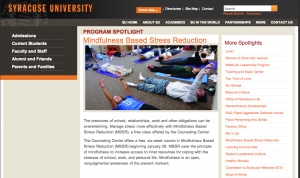My class is still in the “honeymoon phase,” those carefree weeks in the beginning of the semester when students and instructor alike enjoy each other’s company and insights, before any major papers or exams complicate the dynamic. Smaller, low-stakes assessments have given me a chance to provide early feedback and have documented the their good thinking thus far, but the high pressure of the semester is just around the corner.
We see that shift soon enough. The students’ questions become simultaneously more global (“what are you looking for?”) and more pointed (“how exactly did I answer that test question incorrectly?”). With four or five different classes and professors, their attempt to resolve some of these uncertainties is understandable. It’s written in the lines and shadows of their faces, the tensing of their shoulders, the increased companionship of coffee cups and energy drinks.
Most campuses offer academic support to help students study more effectively, navigate their challenges with math, or work through the final revisions of an essay. Most also offer psychological counseling services to help students manage both school-related and personal anxieties. But I’m interested in how some schools have brought mindfulness to campus. Below are a few examples, ranging from quick and easy resources to more immersive training via a formal curriculum:
- MIT has three-minute guided meditations-on-the-go for students, faculty, and staff at 617-253-CALM and longer meditations on their website.
- The University of New Hampshire not only features a page of meditations for easy access; it also offers individual training and even a regular weekly practice for its campus community.
- The University of Vermont also has a page of online practices in addition to a mindfulness listserv, Facebook group, two weekly meditation practices on campus, a variety of workshops, and a day-long retreat.
- Syracuse University offers students a free, six-week mindfulness-based stress reduction (MBSR) program, the Cadillac of mindfulness programs–for free!
- Brown University‘s mindfulness FAQ is directly linked to their list of “common college health issues,” as well as a Contemplative Studies Initiative offering students a formal concentration with courses in the sciences, humanities, and creative arts.

Eydie Cloyd, Vanderbilt University School of Nursing
- Vanderbilt University‘s School of Nursing is incorporating mindfulness into its formal curriculum. (No links are available yet: our mindfulness-teacher training group is supporting fellow member/nursing faculty Eydie Cloyd in developing this multi-year project.)
What does your campus offer? Is anything available to all students? Do any of the models above fit the abilities and resources of your campus? Find out, and make suggestions–for your students.
Practice
If you’re a regular reader of The Mindful PhD, you’ve probably figured out that mindful practices aren’t complicated. They don’t get terribly fancy or ramp up to greater difficulty. (The only increases involve longer “sits” for greater benefits and varied breathing patterns to improve attention to the breath.)
To the right are two simple breathing practices that will feel familiar. If you’re able, try the ten-minute practice. If not, the three-minute session is good as well.






